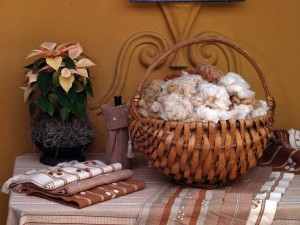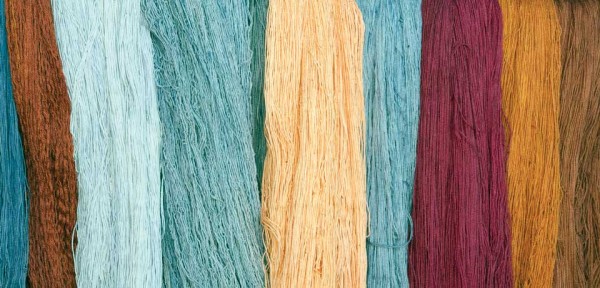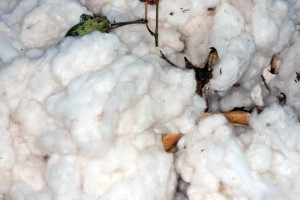The Continuing Search for Original Mayan Cotton
Written by. Dr. Nicholas M. Hellmuth
When you look at the portraits of kings, high priests and other nobles on Mayan stelae, murals or painted ceramics you can see how much attention the Maya dedicated to their clothing. Each ritual, every ceremony, had special clothing. Even peasants wore at least a loincloth.
Most of the women of the elite class wore expertly decorated outfits, almost always of some form of woven cloth. The Maya also made string and cordage (rope and comparable materials) from scores of different roots and vines. The selection of material depended on rank, status, purpose of the clothing, and whether the outfits
were for the hot humid Lowlands or the chilly Highlands.
The ancient Maya (and Aztec and their neighbors) tended to make their clothing from cotton, various kinds of agave or comparable plants, and bark paper. The botanical or Latin name for cotton is Gossypium hirsute. “Cotton” in the form of kapok, from ceiba trees, is a different fiber—important, but not widely used for weaving and clothing.
I had thought there were two world centers of cotton origin: pre-Hispanic Mesoamerica and Egypt. Thus, I was surprised to learn that the primary origins of cotton were, in addition to Mesoamerica (Mexico and Guatemala), in Peru, India and southern Africa. It turns out that the cotton for which Egypt is so famous is a modern-day cotton! I also assumed that Egyptian cotton was white and native Mesoamerican cotton was brown, or at best, off-white. But it turns out that pre-Columbian cotton was probably available in a wide range of many subtle colors. Wild cotton plants are over 2 meters high, some up to almost 3 meters. Cotton in industrial plantations tends to be under 2 meters to facilitate picking by machine. Most of the modern commercial cotton that I have seen is not much above 1 meter in height.
The ancient Maya tended to make their clothing from cotton, various kinds of agave or comparable plants, and bark paper.
The first non-industrial cotton I found in Guatemala was south of Rio Dulce at Frutas del Mundo farms of Dwight Carter. I was shown this interesting agricultural farm by Kevin Lock, a knowledgeable local guide. Algodones Mayas Guatemala sells products made from organic cotton in La Antigua Guatemala; it raises its cotton on the Costa Sur. Also, the cooperative Asociación de Mujeres en Colores Botanicos, at Lake Atitlán, has plenty of locally grown cotton. The cotton flowers may vary in the same plant between rose colored and yellow (one or the other, not in between)
I observed these colors on a large cotton bush while visiting this cooperative. The most informative place for learning about cotton was at the San Juan la Laguna cooperative. It has a museum that shows all the plants, plus the best book you could possibly want on the subject; you can buy this book on natural plant-based color dyes from the Maya women’s cooperative in this village. You can reach this village most easily by boat from Panajachel, or you can drive up and down volcanic slopes for hours (as we did). If you choose to drive, we recommend 4WD and a high axle (big tires).
Twenty years ago much of the Guatemalan south coast was an endless commercial cotton plantation. The quantity of insecticide used to raise this modern Guatemalan cotton is mind-boggling. The pesticide amount was so high that the U.S. was not allowed to import beef in those decades if the cattle grazed anywhere near a cotton field.

above: Dyed cotton fabrics, San Juan La Laguna
below: Cotton display at Algodones Mayas
Guatemala (sofía monzón)
In later years these former cotton plantations were transformed into sugar cane and/or cattle ranches. There is not much industrial monoculture of modern white cotton remaining (fortunately for the environment, as cotton requires more nasty chemicals than any other form of agriculture). The modern colorants include even more carci-nogenic chemicals. So it is important to locate organic cotton and learn where it can be obtained.
Dwight Carter provided hospitality and local knowledge at his Frutas del Mundo farm. Well worth visiting if you are near Rio Dulce. We found the cotton by pure coincidence as we were driving out the gate area, since we visited Dwight’s place to study zapote and annona fruits, not expecting to find cotton.
We appreciate the permission of the organic cotton store, Algodones Mayas Guatemala, to photograph its samples. We look forward to visiting its cotton farm in the Costa Sur when the next crop is available.
Maria Cristina Sicay, of the Asociación de Mujeres en Colores Botanicos, San Juan la Laguna, provided knowledge and hospitality in their facilities. To make an appointment to visit, e-mail: cooperativabotanica@yahoo.com.mx
We also thank Hideo Kojima for his insights on colorants for Maya weaving.
Dr. Nicholas M. Hellmuth is director of FLAAR Reports (Foundation for Latin American Anthropological Research). The full list of all Mayan ethnobotanicals is available at www.maya-ethnobotany.org. If you find any of the plants we have not yet located, please contact us at FrontDesk@FLAAR.org

